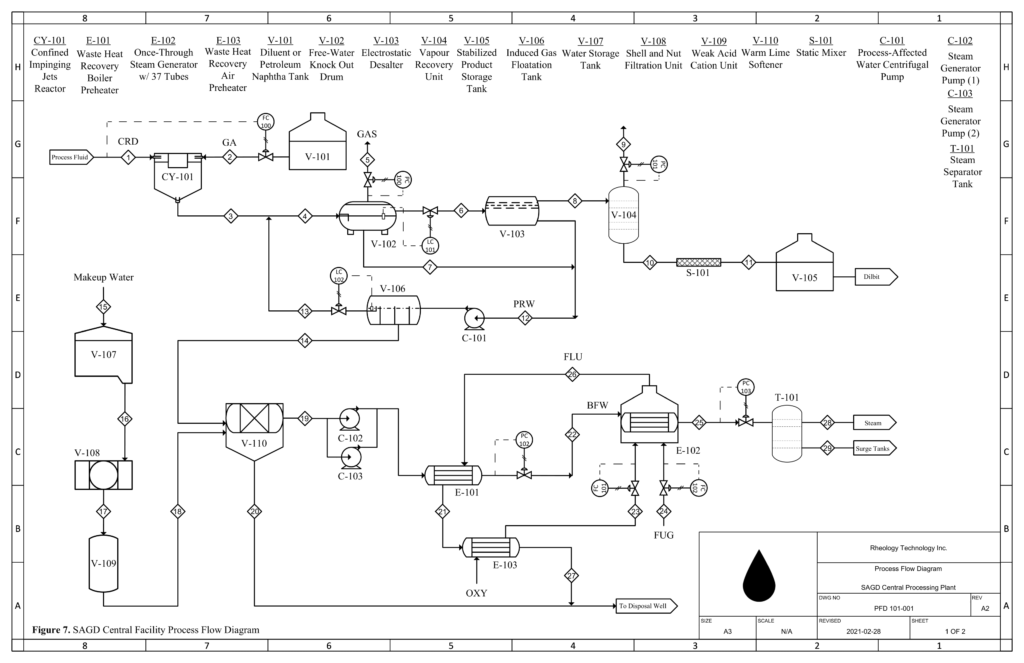Project Category: Chemical
Join our Presentation
Rheology Technology Inc.
Click the logo to join our Zoom meeting.
Problem Statement
The scope of our project is to select the most effective bitumen in-situ extraction and viscosity reduction method from industry proven methods that are being applied to specific formation morphology. Our scheme leads to improved flow resistance from the reservoir to distribution centers. Design selection was based on the process productivity, cost efficiency and economically feasible. Our design will ensure that the bitumen which is to be transported through our plant meets the pipeline specifications so that a smooth and efficient movement of bitumen is achieved to different facilities. Pipeline specification criteria for heavy crude is 100 to 250 centipoises, basic sediment and water (BS&W) is less than 0.5 volume percent and the receipt temperature is at or below 38 degrees Celsius.
Meet our Team Members





Details about our Design
HOW OUR DESIGN ADDRESSES PRACTICAL ISSUES
For extraction purposes, Steam Assisted Gravity Drainage (SAGD) is the process chosen due to its promising high recovery rate and its ability to achieve extraction without causing too much land disturbance. As a matter of fact, it is very a dominant process on a commercial scale for achieving extraction nowadays. Another advantage of SAGD includes that the bitumen viscosity is dramatically lowered from its original viscosity, due to the steam injection before even entering the viscosity reduction unit.

In order to achieve viscosity reduction, diluent is mixed with bitumen to meet pipeline specifications to keep the oil moving in the pipeline. After removing all the water that is mixed with bitumen from SAGD operation, bitumen is moved to the diluent addition unit. For dilution purposes we are using naphtha due to its high efficiency for lowering the bitumen viscosity when compared to the other alternatives. Naphtha is considered a better solvent since it prevents asphaltene build up within the pipeline, and it will be sourced locally from the Sturgeon and Strathcona refineries.

WHAT MAKES OUR DESIGN INNOVATIVE
Our design will consist of certain equipment and features that will enhance the overall process quality of the plant.
They include:
Confined Impinging Jet Reactor: It will ensure a coarse mixing of the bitumen and diluent resulting in to a very low viscosity dilbit which can be transported to different process facilities.
Static Mixer: This will be a secondary mixer after the Confined Impinging Jet Reactor to further enhance the fine mixing of dilbit.
Unit Operations Mobility: Most of the operational units in the whole facility will be easy to relocate so they can be moved at any well pad throughout the field and the upgrading process can be carried out onsite.
Waste Heat Recovery: This unit will help achieve maximum recovery efficiency by using the flue gas in place of regular boiler preheaters and thus lowering fuel and utility costs.
WHAT MAKES OUR DESIGN SOLUTION EFFECTIVE
Our separation equipment is located at the well pads and will make use of the residual heat loss to lower viscosity in the separation process; where the electrostatic desalter acts as a heater treater. Steam generators are also being kept closer to the well pads to minimize any temperature and pressure losses to the surroundings. Another feature that adds to the efficiency and effectiveness of the plant is that it includes the use of naphtha as a source of diluent instead of natural gas condensates since it has a better weathering profile and its price is proportional to that of oil.
HOW WE VALIDATED OUR DESIGN SOLUTION
Initially to select our design solution a comprehensive literature review was done and guided by the Kepner-Tregoe (KT) analysis which helped identify the optimal scheme which would lead to much improved oil recovery and ensures that the product meets transportation specifications. One needs to weigh the success rate, safety concerns, economic sustainability and literature availability related to the choices and then choose the process which performs well in all those areas. In order to address the two problems, a comprehensive survey was conducted to develop and examine various process options. These were weighed according to their economic and energy efficiency, operability, process safety and etc. and ranked them from best-to-worst. The methodology with the highest overall KT score was selected.
To further facilitate the validation of our plant hand written calculations were compared to those derived from Symmetry software which acted hand-in-hand to determine overall mass and energy balance as well as unit specifications.
FEASIBILITY OF OUR DESIGN SOLUTION
Social Analysis
The Government of Alberta has recognized potential shortfalls arising from rapid population growth instigated by accelerated oil sands development and regional development. The government therefore aims to acquire and analyse the changes to population due to migration including demographics and their impacts. Concerns have been raised by Aboriginal and local communities: the influx of non-Aboriginal people onto traditional lands, loss of traditional resources due to development, migration of people to local communities due to lack of housing, and a loss of traditional culture (Poveda & Lipsett, 2013).
Additional concerns have been raised due to the use of industrial camps. Oil sands development require large numbers of personnel required to build, operate, and maintain the projects. Developers often use industrial camps to allocate personnel, rather than relying on housing in the community. This type of allocation generates a series of additional concerns, including the increased potential of forest fires, pressure on the environment, safety, and the potential destruction of sacred sites (Poveda & Lipsett, 2013).
Social issues are expected to occur as the development of the oil sands projects goes on. However, to mitigate or eliminate these issues, the first step towards a sustainable development consists of assessing the impact, followed by monitoring projects. The challenge encountered in achieving this revolves around clarifying how the industry faces two main questions: what should be measured, and how should they be measured (Poveda & Lipsett, 2013).
Environmental Analysis
The environmental footprint is predominantly a consequence of steam generation and water treatment at the central processing facility as the product recovery is conducted belowground. Our water intensive process encourages efficient reuse of process-affected water in addition to high-salinity groundwater rather than freshwater where the steam-oil ratio is a key performance driver. A lower ratio of injected steam to recovered bitumen means leads to lower water and natural gas requirements, and consequently a reduced environmental impact and operating cost (CERI, 2014).
Energy usage and greenhouse gases
Generating high pressure and high-quality steam is energy-intensive and uses natural gas as fuel which leads to greenhouse gas emissions. A full accounting of greenhouse gas emissions from bitumen production includes emissions from direct recovery activities as well as those associated with natural gas production and electricity generation. The implementation of a waste heat generator helps improve overall energy efficiency (The Pembina Institute, 2020).
Water Usage
In-situ SAGD operations consume considerable amounts of water which may disrupt the local environment if insufficiently recycled. Our water treatment process ensures that makeup water, generally sourced from surface runoff and brackish groundwater is minimized through recycle (The Pembina Institute, 2020).
Land Disturbance
Surface footprints of in-situ SAGD projects are considerably smaller than surface mines as recovery takes place mostly underground. However, direct land disturbances of in-situ operations like seismic lines, roads, pipelines, power lines and well pads contribute to linear disturbances that can affect animal habitats (The Pembina Institute, 2020).
Air Emissions
Although in-situ SAGD processes primarily use cleaner-burning natural gas as fuel source, there are still emissions that arise from operation beyond greenhouse gases which include nitrogen oxides, sulphur dioxide, volatile organic compounds, and particulate matter. These emissions have the potential for health and environmental hazards which must be minimized (The Pembina Institute, 2020).
Safety Analysis
The practiced system employs various dynamic facets to achieve process safety and reliability. The multimodal model is tasked to continuously access and understand managed hazards and risks to deliver the desired outcomes. Developed practices and procedures as detailed through the process management framework seeks to implement or retool inherent, passive, and active strategies as risk mitigating measures. Furthermore, the executed protocols are appropriately presented or instructed, documented and are updated as required. The design basis emphasizes these principles throughout the process and developed control philosophy (APEGGA, 2006).
The operating facility adheres to inherent plant safety principles. These guiding principles serve to safeguard operator health and safety as well as plant operational excellence. The framework incorporates or seeks to modify through minimization or substitution and process attenuation or simplification. For instance, the free-water knockout pot incorporates a float and lever assembly as interface control which employs the keep it super simple (KISS) design principle. The process further determined to source an inherently safer diluent material or where natural gas condensate is replaced with petroleum naphtha; a chemical or material which has a higher flash point and boiling point. Furthermore, the raw material inventory or diluent is minimized through just-in-time supply-chain management; a strategy which inherently reduces process hazards and potential incident severity and a reduction in inventory hold cost. In addition, pipe racks located at each pad enhance production integrity and safety of personnel. The hazards inherent to the process were further moderated through over specifying unit sizing over and above the minimum or fit-for-purpose requirement to accommodate a margin of safety and in order to attenuate process conditions or potential ramp-up (Ortiz-Espinoza, Jiménez-Gutiérrez, & El-Halwagi, 2017).
Process equipment are detailed or specified with a comprehensive control scheme. The layers of protection approach is a semi-analytic technique developed to identify, assess and mitigate hazards and risks. The methodology establishes possible incident scenarios and potential points of failure through roots cause analysis as well as determining or estimating the probability or severity of consequent events or failures. The framework employs primary and secondary logic devices which act as basic and redundant process control such as in the free-water knockout unit where the float and lever assembly are accompanied by a secondary control valve with set high- and low-level alarms. Furthermore, the approach specifies critical physical protections such as pressure relief devices, process containment and a comprehensive plant or community emergency response.
Partners and Mentors
We want to thank the many people who helped us with this project. Our chemical engineering professor Dr. Ayodeji Jeje guided us through the process with patience and great advice. And, our consultation with Heejin Noh was invaluable.
Photo Gallery
References
Xu, L., Abedini, A., Qi, Z., Kim, M., Guerrero, A., & Sinton, D. (2018, 05 15). Pore-scale analysis of steam-solvent coinjection: azeotropic temperature, dilution and asphaltene deposition. Fuel: The science and technology of Fuel and Energy, 151-158. doi:https://doi.org/10.1016/j.fuel.2018.01.119
APEGGA. (2006). Guideline for Management of Risk in Professional Practice. Edmonton: The Association of Professional Engineers, Geologists and Geophysicists of Alberta. Retrieved from https://www.apega.ca/docs/default-source/pdfs/risk.pdf?sfvrsn=b4ad93b_2
Ortiz-Espinoza, A. P., Jiménez-Gutiérrez, A., & El-Halwagi, M. M. (2017). Including Inherent Safety in the Design of Chemical Processes. American Chemical Society: Industrical & Engineering Chemistry Research, 14507-14517. doi:https://doi.org/10.1021/acs.iecr.7b02164
Poveda, C. A., & Lipsett, M. G. (2013). The Canadian oil sands: environmental, economic, social, health, and other impacts. Edmonton: University of Alberta.
CERI. (2014). Oil Sands Environmental Impacts. Calgary: Canadian Energy Research Institute. Retrieved from https://ceri.ca/studies/oil-sands-environmental-impacts
The Pembina Institute. (2020). What is the highest environmental impact oil? Calgary: The Pembina Institute.
 k
k
